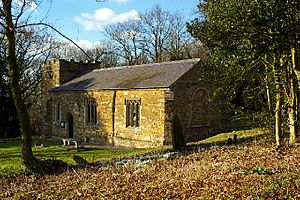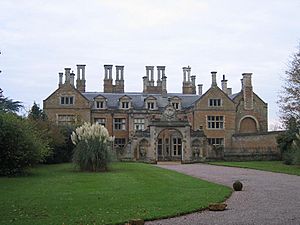Edward Rossiter facts for kids
Quick facts for kids
Sir
Edward Rossiter
|
|
|---|---|

St Margaret's, Somerby where Rossiter was buried
|
|
| Deputy Lieutenant of Lincolnshire | |
| In office August 1660 – January 1669 |
|
| Member of Parliament for Lincolnshire |
|
| In office April 1660 – December 1660 |
|
| Member of Parliament for Great Grimsby |
|
| In office March 1646 – December 1648 (excluded in Pride's Purge) |
|
| Personal details | |
| Born | 1 January 1618 Somerby |
| Died | 9 January 1669 (aged 51) Somerby |
| Resting place | St Margaret's, Somerby |
| Nationality | English |
| Political party | Parliamentarian |
| Spouses | (1) Jane Samwell (1646-?) (2) Arabella Holles (1660-1669) |
| Children | (1) Mary and Elizabeth (2) John, Edward, Horatio, Richard and Vere |
| Alma mater | Sidney Sussex College, Cambridge |
| Occupation | Soldier and politician |
| Military service | |
| Allegiance | |
| Years of service | 1642 to 1648 |
| Rank | Colonel |
| Battles/wars |
|
Sir Edward Rossiter (born 1 January 1618 – died 9 January 1669) was an English landowner, soldier, and politician. He came from Lincolnshire and fought for the Parliamentarian army during the Wars of the Three Kingdoms. He also served as a Member of Parliament (MP) at different times between 1646 and 1660.
When the First English Civil War began in 1642, Rossiter joined the Eastern Association army. Later, he moved to the New Model Army in 1645. He was also important in the local government of the East Midlands. In 1646, he became an MP for Grimsby.
From February to July 1647, he was in charge of the guards at Holdenby House. This was where King Charles I was being held. However, the Army Council removed him. They thought he was on the side of their opponents in Parliament.
During the Second English Civil War in 1648, Rossiter rejoined the army. He helped stop revolts by Royalist supporters in South Yorkshire and Lincolnshire. In December 1648, he was one of the MPs removed from the House of Commons by Pride's Purge. Unlike his grandfather, Sir John Bourchier, Rossiter was against the Execution of Charles I in January 1649.
During the time without a king, known as The Protectorate, Rossiter was elected as an MP for Lincolnshire. He was elected in 1654, 1656, and 1659. But he was not allowed to take his seat. This was because he was suspected of being a Royalist supporter.
He supported the return of the king, known as the Stuart Restoration. For his support, he was made a knight in May 1660. He was also appointed Deputy Lieutenant of Lincolnshire. After this, he left politics and passed away in January 1669.
Contents
Who Was Edward Rossiter?
Edward Rossiter was born on 1 January 1618. He was the second son of Richard and Elizabeth Rossiter. His family lived in Somerby by Bigby, Lincolnshire. He had two older brothers, Richard and John.
His mother was the daughter of Sir John Bourchier. Sir John was a strong Puritan. He was one of the judges at the trial of King Charles I in 1649. After the king returned in 1660, Sir John was going to be put on trial. But he died of an illness before that could happen.
Edward became the main heir to the family home in Somerby. This happened when his older brother Richard died in 1636. In 1646, Edward married Jane Samwell. They had two daughters, Mary and Elizabeth.
He married again in 1660 to Arabella Holles. She was the daughter of John Holles, 2nd Earl of Clare. Her uncle was Denzil Holles, 1st Baron Holles. Denzil Holles was one of the Five Members whom King Charles I tried to arrest in 1642. This event was a big step towards the Civil War. Edward and Arabella had five children who were still alive when he died. Their names were John, Edward, Horatio, Richard, and Vere.
Edward Rossiter's Early Life and Education
The Rossiter family was part of the middle class of landowners in Lincolnshire. After his father died in 1620, Edward's mother took her children to live with her father in Yorkshire. Edward went to Kirton and Beverley Grammar School. Later, in 1636, he studied at Sidney Sussex College, Cambridge.
Fighting in the First English Civil War
When the First English Civil War started in August 1642, Edward Rossiter joined the Parliamentarian army. He became a captain in a cavalry unit. This unit was first only allowed to fight in Lincolnshire.
In April 1643, Rossiter was promoted to Colonel. His unit became part of the Eastern Association army. This army was led by Lord Willoughby.
In 1643, Royalist forces took Gainsborough. The Eastern Association army took it back on 16 July. On 28 July, Rossiter was with Oliver Cromwell when they fought off a Royalist force near Gainsborough.
Newark was a very important place. It connected the Royalist capital of Oxford with their armies in the north. Rossiter spent the next two years near Melton Mowbray. His job was to help block the Royalists in Newark. In March 1644, he was part of a force defeated near Newark by Prince Rupert. Even though Newark stayed in Royalist hands, Parliament took control of the areas around it.
In February 1645, Rossiter stopped Royalist cavalry near Melton Mowbray. These cavalry, led by Sir Marmaduke Langdale, were trying to help the siege of Pontefract Castle. Rossiter's men had to retreat. He tried to block Langdale near Doncaster, but it was too late.
In April, Rossiter's unit joined the New Model Army. This was a new, well-trained army. His unit was the only one not from the main Parliamentarian armies. Its main job was to keep Lincolnshire safe. In June, his unit was at the Battle of Naseby. This was a big victory for Parliament. It greatly weakened the Royalist forces.
Rossiter stayed in the region after the battle. He played a key role in the local government of the Eastern Association. In October 1645, he captured letters. These letters showed that King Charles was trying to get help from the Irish Confederacy. Parliament used these letters to show that the king could not be trusted.
Rossiter also helped negotiate with Royalists who wanted to surrender. When Prince Rupert and his brother Maurice were dismissed by the king, Rossiter helped them get permission to leave England. In March 1646, Rossiter became an MP for Great Grimsby. This was after the previous MP, Gervase Holles, was removed for being a Royalist.
The king, now close to defeat, left Oxford in disguise on 27 April. He joined the Scottish army near Newark. The Scottish army surrendered Newark the next day. The Scots then took the king north to Newcastle.
The Second English Civil War and Its Aftermath
Parliament wanted to make a deal with the king, not remove him. But there were disagreements about the terms. These arguments divided the moderate members of Parliament from the more radical soldiers in the New Model Army. In January 1647, a committee that had governed England and Scotland was replaced. The new committee was led by Holles and included moderate MPs like Rossiter.
They paid the Scots to return to Scotland and hand over King Charles. The king was taken to Holdenby House, near Holmby in Northamptonshire. Rossiter's soldiers were part of his guard there.
The disagreements between Parliament and the Army Council grew worse. The army was owed a lot of unpaid wages. Parliament ordered the army to go to Ireland. They said only those who agreed would be paid. But the soldiers demanded full payment for everyone first. The army was ordered to be disbanded, but the Army Council refused. In early June, soldiers from the New Model Army took King Charles from Holdenby House. The Army Council saw Rossiter as unreliable and removed him in August.
When the Second English Civil War started in April 1648, the New Model Army faced many uprisings across England and South Wales. There was also a Scottish invasion. The army needed more soldiers. On 6 June, Rossiter was called back to duty. He was sent to Lincoln to secure the Midlands.
The Parliamentarian soldiers at Pontefract joined the Royalists. Other rebels also joined them. They sent about 1,000 men into Lincolnshire to get supplies. Rossiter chased them and defeated them near Willoughby on 5 July. John Lambert, the Parliamentarian commander in the north, left Rossiter to manage the siege of Pontefract. Lambert then went to oversee the campaign that ended with the Battle of Preston in August.
The Second Civil War was very harsh. Royalist prisoners who had been released before were often executed. But Rossiter helped save some prisoners taken at Willoughby. These included Sir Philip Monckton and Gilbert Byron. Rossiter reportedly convinced Sir Thomas Fairfax to set them free.
Life After the War and the King's Return
Moderate politicians like Holles really wanted to make a deal with King Charles. But the king would not agree to important changes. This made Cromwell and his supporters think that more talks were useless. Rossiter was one of the MPs who supported Holles. He voted to continue talking with the king. Because of this, he was removed from Parliament by Pride's Purge on 6 December 1648.
Unlike his grandfather, Rossiter was against the Execution of Charles I in January 1649. He spent most of the time without a king (1649 to 1660), known as the Interregnum, out of public view. Even though he was elected MP for Lincolnshire in 1654, 1656, and 1659, he was not allowed to sit in Parliament. This was because he was suspected of being a Royalist. There was some truth to this, as he was thought to be involved in the Booth's Uprising in 1659.
Rossiter supported the return of King Charles II. This event is called the Restoration. In April 1660, he was elected for Lincolnshire in the Convention Parliament. He was part of the group sent to welcome King Charles when he arrived in England. On 27 May, he was made a knight. In August, he was appointed Deputy Lieutenant of Lincolnshire. However, he did not run for Parliament again in 1661. He died of cancer at his home in Somerby on 9 January 1669.
Sources


